 In 2011 I wrote a three-part series of articles about a principle that helps families manage better. I must confess it’s a principle I still work on because it isn’t easy to keep. I know the stories and the principle are worth repeating because principles never change and when lived, they impact us for good. I’m compiling the three-part series into one article. That will keep it simple for you. LOL
In 2011 I wrote a three-part series of articles about a principle that helps families manage better. I must confess it’s a principle I still work on because it isn’t easy to keep. I know the stories and the principle are worth repeating because principles never change and when lived, they impact us for good. I’m compiling the three-part series into one article. That will keep it simple for you. LOL
A Simple and Peaceful Holiday Celebration
I believe that intentionally keeping things simple is a principle that leads to peace. I want to share how my husband, Don, and I used this principle in 2011 to have that peace. We decided we weren’t going to spend any money. You heard right, no money (except for shipping.) We would have to give it some thought to bring it about. Also, we were going to be picky about what events we joined in.
We did well at keeping our decision. We did spend a little over $20 on three children, bought some cookie-making ingredients, and Don cheated and bought me a book. He knows I love books. LOL
How This Decision to Simplify Brought Us Peace
We only went shopping once, for forty minutes. Not shopping was an amazing experience. It gave us more time to be together. We spent time each evening curled up on our sofa reading Christmas stories and drinking hot cocoa. It was wonderful. We didn’t have to fight traffic, or crowds, or worry about accumulating debt. That was very freeing.
We sent our grown children books, which we selected out of our personal library. We choose what would be meaningful to them, would help them in some way, or that they would love reading. Our sons, like their dad, are not readers, but Don loves coffee table books, and we knew the boys would too. We also sent mementos of the past that we felt would bring joy and touch the hearts of our children.
What Happened For Two of Our Sons
We sent Seth a karate gee he wore when he was nine. He told me how fun it was to receive because it still fit. He said, “The legs and sleeves are short, but it fits.” He was in his 30’s at the time. He was glad to know that the gee still existed, and he now had it. He loved the gift.
We sent Andrew a Christmas plaque that had hung in our home since the year he was born. I made it and it was a homely little thing. His sister, Jenny, who roomed with him at the time, said when he opened his gift, his eyes got tearful. He said it was a ‘cool’ present and he thought Jenny was a tad jealous. : )
How Did We Do with the Grands
I worried about how our grandchildren would feel about their gifts. To one family, with four children, we sent ten envelopes, each containing a picture or story and six small pieces of candy. Each story or picture had something to do with the Christmas season and its purpose. It was just paper and a few bits of candy. Yet when I asked Marie what the children thought she replied, “They were so excited.” Aubrey, who was eleven said, “We have the best grandma and grandpa in the whole world”. This from an almost teenager!
The grands all loved whatever they got. It didn’t matter if it was large or small. Not one was disappointed that money hadn’t been spent.
Going the Extra Mile and Not Going
For the 21 years we lived in Laurel, MT. my best friend, Linda Brannon, would bring us a HUGE platter of assorted cookies. Because we had seven children, she didn’t bring a token plate, she brought a platter. It was the highlight of the season for our kids, even though I was a baker. LOL For Linda it was a labor of love, and our children knew she loved our family.
About a week before Christmas in 2011, Jodie, my oldest daughter, mentioned she felt nostalgic about those cookies. I decided I would recreate the experience for her as a special gift. I took one Saturday and baked up a storm. Then Don and I gifted the cookies to her.
Later she told me this story. Her husband had been feeling a bit down. He didn’t have the Christmas spirit. Both of Doug’s parents are deceased. Jodie said that when the cookies came into their home his entire countenance changed. He became animated, happy, and full of joy. I think it reminded him of his mother and home.
I decided to have another baking day to give more cookies to other families. In the moment of that thought I had a clear impression, “LET IT GO, it isn’t necessary.” I followed that thought and spent the day loving and being present with my family instead.
And What About Mom?
I wanted to do something special for my mom, she was 80 and lived alone. She had everything she needed as far as worldly possessions. Here is what she didn’t have, the sure knowledge that she has done a good job as a parent even though it ought to be obvious to her. But mothers do this, they worry about what they didn’t do and undervalue what they do.
I pondered what to give her. I had an idea I am sure was from God. It was to write her a letter. I even had thoughts about what to say. I sat down and wrote a nice letter. When I prepared to mail it, I felt, “No, it isn’t done.” I STOPPED and thought about it some more. Then I spent the next five hours rewriting the letter. It took a lot longer than I had anticipated. I dug through old papers and found the poems she had written to accompany her gifts to us. For example, one year she sent a HUGE box of homemade caramel corn with this poem.
A Kernel of Love
Sometimes all you can do is not very much
For reasons hard to define.
Yet you’d like to do “oh so many things”
To make everything “just fine”.
This package is all I have to offer
To show how much we care.
But every kernel is a bit of love
And the sweet is the love we share.
May you remember the things we’ve done,
With fondness, with each tasty bite.
And maybe somehow, we can join our souls,
And everything “Will Be Alright”!
by NaVon Cazier
This was one of our children’s favorite gifts that year. I ended the letter with this:
“All the years of my growing up you demonstrated to me how to live gracefully and abundantly no matter what was happening. I think this has been an amazing gift and has made it possible for me to do the same. All I can give you this year Mom, is my love and gratitude for a mother who lived fully despite lots of kids, no money, no car, and you being alone a lot of the time. It has made all the difference in my life. I love you so much. Merry Christmas.”
One Final Story from Our Christmas of Peace Experiment
My father was an educator. He developed a testing device to find learning disabilities in children and spent many years working with them. However, in his heart of hearts, he was a restaurateur. We always had a drive-in or restaurant of some kind.
He was also a preparer, preparing for what might happen in life. He loved storing food, blankets, water, you name it. When he passed away, we had a basement of ‘stuff’ to sift through. One of the things we found was a box of bagged nutmeg. We are talking pounds of nutmeg! After my five sisters took what they wanted I came home with about 40 pounds of the spice.
As we contemplated what we could do to show our friends, neighbors, and church members our appreciation for their friendship over the years we had an idea. We bagged the nutmeg into ¼ pound bags and tied them to four delicious and delightful nutmeg cookie recipes.
As Kate, our one remaining child at home, and I bagged nutmeg, I felt my father was with us, was happy we hadn’t thrown the nutmeg away, and happy that we were putting it to good use. When we had made over 100 gift bags to share, I had about 6 pounds left. Then I had this distinct impression: “Save the rest. You can barter it.” Good grief, that was so my dad. : )
What About the Parties?
We decided not to attend everything that came along. We were going to be picky about where and when we celebrated. We attended Don’s work party, and one church party, went to Temple Square with my youngest daughter’s future in-laws, and spent time in the homes of family. That was it.
I really do believe that keeping things simple brings peace whether we’re talking about family schedules, how we prepare our homes or yards, birthdays, our work, or the gifts we give at Christmas. It’s paramount to remember what is important. Keeping it Simple, is vital to peace of mind, doing what is needed, and making way for good things to come into our lives.
What I am not saying is that we shouldn’t shop, buy gifts, attend parties, or cook for a week, if that is what we are moved to do. What I am saying is that it’s important to avoid unrealistic expectations from ourselves and others. It’s important to avoid needless busyness. It’s important to determine what is most needful and let the rest go.
Because Don and I made an intentional pact To Keep It Simple, we got what we needed and gave our family what they needed. It was a remarkable season. The sense of peace and joy came from doing less and not from doing it all. The whole point of the decision that Don and I made in 2011 was to live the principle of keeping it simple and peaceful. Our intentional efforts paid dividends.
May each of you have a simpler and more peaceful holiday season. I plan to do the same.
Intentionally keeping things simple will help us feel and be more successful.
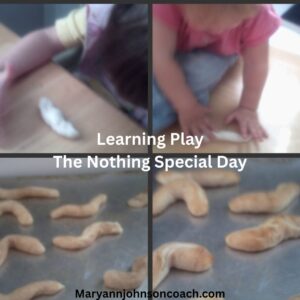 Back in the day, when my grands were small, I did many learning activities with them. I enjoyed it and so did they. As I mentioned earlier this spring, I’m sharing some of those past learning activities with you because you can have as much enjoyment and fun with your children or grands as I did. Sometimes all we need is an idea, and then we can run with it. So here goes!
Back in the day, when my grands were small, I did many learning activities with them. I enjoyed it and so did they. As I mentioned earlier this spring, I’m sharing some of those past learning activities with you because you can have as much enjoyment and fun with your children or grands as I did. Sometimes all we need is an idea, and then we can run with it. So here goes!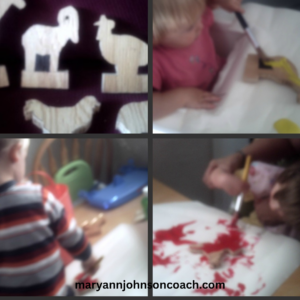 paper. When they were done and wanted another animal and a different color, we traded papers. Grandpa was very satisfied with the result. This particular range wouldn’t have his usual perfection, but it had memories and was fun to use.
paper. When they were done and wanted another animal and a different color, we traded papers. Grandpa was very satisfied with the result. This particular range wouldn’t have his usual perfection, but it had memories and was fun to use.

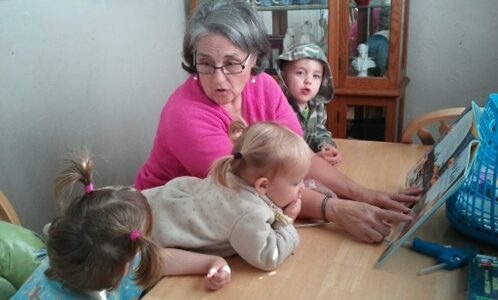
 One day in 2011, I found the most amazing book at the library!!! I happened across it accidentally. It was about Leonardo Da Vinci and the amazing visions he had. But that wasn’t all. The book showed how, in time, all his inventive ideas were created by other people and who those people were. Oh my gosh, I wanted to share this with my grands.
One day in 2011, I found the most amazing book at the library!!! I happened across it accidentally. It was about Leonardo Da Vinci and the amazing visions he had. But that wasn’t all. The book showed how, in time, all his inventive ideas were created by other people and who those people were. Oh my gosh, I wanted to share this with my grands. Our Super-duper Rocket-propelled Robot
Our Super-duper Rocket-propelled Robot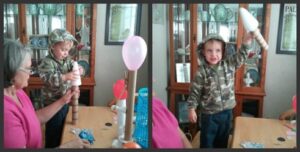
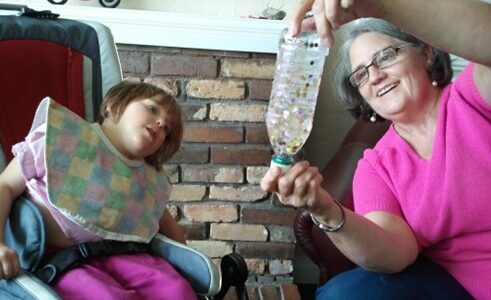
 Summer is the perfect time to learn about stars because after you do a few fun activities, you can lie under the stars as a family, breathe the air, and stare into the night sky. What a relaxing thing to do. As I said a few weeks ago, this summer I am sharing some old grandma school times I had with my grands back in 2011. Bigger kids like helping younger ones, so even though these are simple things, you can do them as a family and get the older kids involved. Just don’t pick a Friday or Saturday night. : )
Summer is the perfect time to learn about stars because after you do a few fun activities, you can lie under the stars as a family, breathe the air, and stare into the night sky. What a relaxing thing to do. As I said a few weeks ago, this summer I am sharing some old grandma school times I had with my grands back in 2011. Bigger kids like helping younger ones, so even though these are simple things, you can do them as a family and get the older kids involved. Just don’t pick a Friday or Saturday night. : )

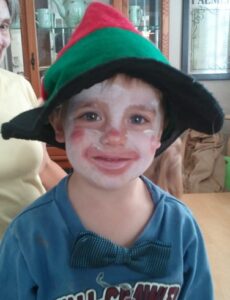 white face paint and lipstick. The white face paint was Halloween makeup I bought many years ago. It worked well enough. For red, we used what grandma had, lipstick. As I say, keep it simple. Then we tried on all the glasses, boas, ties, and other costume items. Jack fell in love with a hat and a bow tie. He asked me if he could have them. I said he could surely borrow them. “I don’t like borrow” he said, “I want to have them!” LOL
white face paint and lipstick. The white face paint was Halloween makeup I bought many years ago. It worked well enough. For red, we used what grandma had, lipstick. As I say, keep it simple. Then we tried on all the glasses, boas, ties, and other costume items. Jack fell in love with a hat and a bow tie. He asked me if he could have them. I said he could surely borrow them. “I don’t like borrow” he said, “I want to have them!” LOL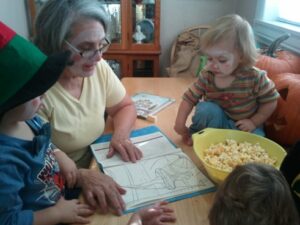 sometimes we aren’t! We managed with what we had, and I made a circus book. I found a terrific site of circus pictures, printed them off, and put them into a binder. (Jack, Mary, and Maggie used it until it fell apart.) It also made a great circus coloring book.
sometimes we aren’t! We managed with what we had, and I made a circus book. I found a terrific site of circus pictures, printed them off, and put them into a binder. (Jack, Mary, and Maggie used it until it fell apart.) It also made a great circus coloring book.
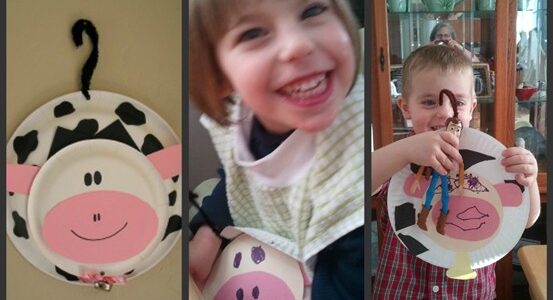
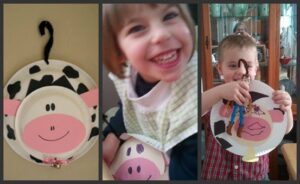 When I first began writing and publishing articles, it was in 2010. My grands, the ones I still live with, were all under five. As their grandma, I wanted to find ways to play and connect. I’m not a board game person! Tea parties and dress up are not on my list of fun things! The truth is, I like learning. I always have. I thought a lot about how I could ‘play’ with my grands and make it work for all of us. What I came up with was learning for fun. Every Tuesday, for several years, we would gather and play/learn. They looked forward to it and occasionally would tell me what they wanted to know or ask about at our next Tuesday session. It was a hit and was called Grandma School. : )
When I first began writing and publishing articles, it was in 2010. My grands, the ones I still live with, were all under five. As their grandma, I wanted to find ways to play and connect. I’m not a board game person! Tea parties and dress up are not on my list of fun things! The truth is, I like learning. I always have. I thought a lot about how I could ‘play’ with my grands and make it work for all of us. What I came up with was learning for fun. Every Tuesday, for several years, we would gather and play/learn. They looked forward to it and occasionally would tell me what they wanted to know or ask about at our next Tuesday session. It was a hit and was called Grandma School. : ) the pictures and I told them fun cow facts, such as, “Did you know a cow has four stomachs. You only have one, but a cow has four!!” That type of comment is usually followed by a question such as “Why Grandma?” Then we get to learn a bit more. Jack’s favorite cow fact was: “Daddy cows are called bulls and they go Moo really, really loud.” I did such a great daddy cow impersonation that it sent Jack into gales of laughter.
the pictures and I told them fun cow facts, such as, “Did you know a cow has four stomachs. You only have one, but a cow has four!!” That type of comment is usually followed by a question such as “Why Grandma?” Then we get to learn a bit more. Jack’s favorite cow fact was: “Daddy cows are called bulls and they go Moo really, really loud.” I did such a great daddy cow impersonation that it sent Jack into gales of laughter.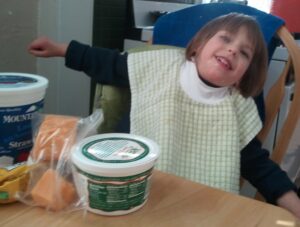 After the books, we did a cow activity. I had created a picture sheet on my computer that showed cool foods that are made from cow’s milk: cheese, cream, ice cream, milk for cereal, cottage cheese, sour cream, etc. I also had the real item on the table, if we had it. We looked at the pictures, talked about each item, and then tasted it. Of course, we all liked the cookie dough best. (It has milk in it!)
After the books, we did a cow activity. I had created a picture sheet on my computer that showed cool foods that are made from cow’s milk: cheese, cream, ice cream, milk for cereal, cottage cheese, sour cream, etc. I also had the real item on the table, if we had it. We looked at the pictures, talked about each item, and then tasted it. Of course, we all liked the cookie dough best. (It has milk in it!)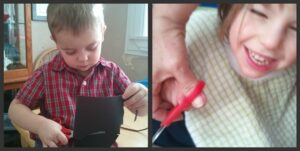 way, but then switched to using two hands and having me hold and turn the paper. Special scissors with 4 finger holes allowed me to help Maggie cut her own cow spots. She was thrilled. (Remember, Maggie, who is now eighteen, has severe cerebral palsy, so doing anything with help thrilled her and still does.)
way, but then switched to using two hands and having me hold and turn the paper. Special scissors with 4 finger holes allowed me to help Maggie cut her own cow spots. She was thrilled. (Remember, Maggie, who is now eighteen, has severe cerebral palsy, so doing anything with help thrilled her and still does.)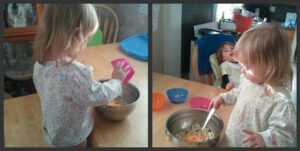 We ended the day by making mac and cheese. Cooking was a favorite activity, so everyone helped. The kids liked tasting the powdered cheese. We had our mac and cheese for lunch, and it was delicious. Maggie, Jack, and Mary decided that having cows in our world is a very good thing.
We ended the day by making mac and cheese. Cooking was a favorite activity, so everyone helped. The kids liked tasting the powdered cheese. We had our mac and cheese for lunch, and it was delicious. Maggie, Jack, and Mary decided that having cows in our world is a very good thing.
 I have learned from lived experience that simple systems are usually the solution to difficult problems in time and life management. This was not an easy lesson to learn, and I occasionally still ignore this truth, but when I do,
I have learned from lived experience that simple systems are usually the solution to difficult problems in time and life management. This was not an easy lesson to learn, and I occasionally still ignore this truth, but when I do,
 In 2011 I wrote a three-part series of articles about a principle that helps families manage better. I must confess it’s a principle I still work on because it isn’t easy to keep. I know the stories and the principle are worth repeating because principles never change and when lived, they impact us for good. I’m compiling the three-part series into one article. That will keep it simple for you. LOL
In 2011 I wrote a three-part series of articles about a principle that helps families manage better. I must confess it’s a principle I still work on because it isn’t easy to keep. I know the stories and the principle are worth repeating because principles never change and when lived, they impact us for good. I’m compiling the three-part series into one article. That will keep it simple for you. LOL
 I have a short list of thoughts/ideas I’m pondering. This list keeps important objectives at the front of my mind lest I forget. : )
I have a short list of thoughts/ideas I’m pondering. This list keeps important objectives at the front of my mind lest I forget. : )
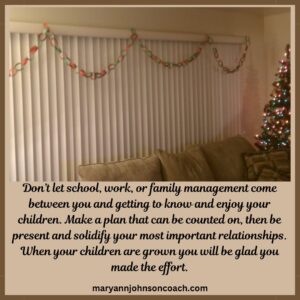 Thirteen years ago, I had a wonderful evening with my eight-year-old friend, Hailey. It was successful because time had been set apart for the activity, it happened consistently so Hailey could count on it, and I was present. When we want to solidify relationships in our family these three ingredients make all the difference.
Thirteen years ago, I had a wonderful evening with my eight-year-old friend, Hailey. It was successful because time had been set apart for the activity, it happened consistently so Hailey could count on it, and I was present. When we want to solidify relationships in our family these three ingredients make all the difference. 

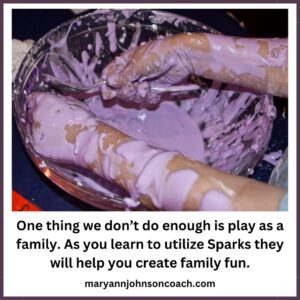 Two weeks ago, I shared
Two weeks ago, I shared